Albedo of a Small Ice-Covered Boreal Lake: Daily, Meso-Scale and Interannual Variability on the Background of Regional Climate
Abstract
:1. Introduction
2. Materials and Methods
3. Results
3.1. Climatic Variability
3.2. Ice and Snow Thickness
3.3. Solar Radiation and Albedo Variability
4. Discussion
5. Conclusions
Author Contributions
Acknowledgments
Conflicts of Interest
References
- Liang, S.L.; Wang, K.C.; Zhang, X.T.; Wild, M. Review on estimation of land surface radiation and energy budgets from ground measurement, remote sensing and model simulations. IEEE J. Sel. Top. Appl. Earth Obs. Remote Sens. 2010, 3, 225–240. [Google Scholar] [CrossRef]
- Stephens, G.L.; Li, J.; Wild, M.; Clayson, C.A.; Loeb, N.; Kato, S.; L’Ecuyer, T.; Stackhouse, P.W., Jr.; Lebsock, M.; Andrews, T. An update on Earth’s energy balance in light of the latest global observations. Nat. Geosci. 2012, 5, 691–696. [Google Scholar] [CrossRef]
- Hall, A.; Qu, X. Using the current seasonal cycle to constrain snow albedo feedback in future climate change. Geophys. Res. Lett. 2006, 33. [Google Scholar] [CrossRef] [Green Version]
- Mironov, D.; Heise, E.; Kourzeneva, E.; Ritter, B.; Schneider, N.; Terzhevik, A. Implementation of the lake parameterisation saheme FLake into the numerical weather prediction model COSMO. Boreal Environ. Res. 2010, 15, 218–230. [Google Scholar]
- Pirazzini, R. Challenges in Snow and Ice Albedo Parameterizations. Geophysica 2009, 45, 41–62. [Google Scholar]
- Liang, S.L.; Li, X.; Wang, J. Advanced Remote Sensing: Terrestrial Information Extraction and Applications, 1st ed.; Academic Press: Oxford, UK, 2012; p. 800. ISBN 978-0-12-385955-6. [Google Scholar]
- Du, J.; Kimball, J.S.; Duguay, C.; Kim, Y.; Watts, J.D. Satellite microwave assessment of Northern Hemisphere lake ice phenology from 2002 to 2015. Cryosphere 2017, 11, 47–63. [Google Scholar] [CrossRef] [Green Version]
- He, T.; Liang, S.; Song, D.-X. Analysis of global land surface albedo climatology and spatial-temporal variation during 1981–2010 from multiple satellite products. J. Geophys. Res. Atmos. 2014, 119, 10281–10298. [Google Scholar] [CrossRef]
- Leppäranta, M.; Kosloff, P. The thickness and structure of Lake Pääjärvi ice. Geophysica 2000, 36, 233–248. [Google Scholar]
- Ashton, G.D. River and lake ice thickening, thinning and snow ice formation. Cold Reg. Sci. Technol. 2011, 68, 3–19. [Google Scholar] [CrossRef]
- Leppäranta, M. Freezing of Lakes and the Evolution of Their Ice Cover, 1st ed.; Springer: Berlin/Heidelberg, Germany, 2014; p. 311. ISBN 978-3-642-29081-7. [Google Scholar]
- Lei, R.; Leppäranta, M.; Cheng, B.; Heil, P.; Li, Z. Changes in ice-season characteristics of a European Arctic lake from 1964 to 2008. Clim. Chang. 2012, 115, 725–739. [Google Scholar] [CrossRef]
- Petrov, M.P.; Terzhevik, A.Y.; Palshin, N.I.; Zdorovennov, R.E.; Zdorovennova, G.E. Absorption of Solar Radiation by Snow-and-Ice Cover of Lakes. Water Resour. 2005, 32, 496–504. [Google Scholar] [CrossRef]
- Warren, S.G. Optical properties of snow. Rev. Geophys. Space Phys. 1982, 20, 67–89. [Google Scholar] [CrossRef]
- Jakkila, J.; Leppäranta, M.; Kawamura, T.; Shirasawa, K.; Salonen, K. Radiation transfer and heat budget during the ice season in Lake Pääjärvi, Finland. Aquat. Ecol. 2009, 43, 681–692. [Google Scholar] [CrossRef]
- Fritsen, C.H.; Priscu, J.C. Seasonal change in the optical properties of the permanent ice cover on Lake Bonney, Antarctica: Consequences for lake productivity and phytoplankton dynamics. Limnol. Oceanogr. 1999, 44, 447–454. [Google Scholar] [CrossRef]
- Bolsenga, S.J. Short note: Preliminary observations on the daily variation of the albedo. J. Glaciol. 1977, 18, 517–521. [Google Scholar] [CrossRef]
- Pirazzini, R.; Vihma, T.; Granskog, M.A.; Cheng, B. Surface albedo measurements over sea ice in the Baltic Sea during the spring snowmelt period. Ann. Glaciol. 2006, 44, 7–14. [Google Scholar] [CrossRef]
- Lei, R.; Leppäranta, M.; Erm, A.; Jaatinen, E.; Pärn, O. Field investigations of apparent optical properties of ice cover in Finnish and Estonian lakes in winter 2009. Est. J. Earth Sci. 2011, 60, 50–64. [Google Scholar] [CrossRef] [Green Version]
- Mullen, P.C.; Warren, S.G. Theory of the optical properties of lake ice. J. Geophys. Res. Atmos. 1988, 93, 8403–8414. [Google Scholar] [CrossRef]
- Gardner, A.S.; Sharp, M.J. A review of snow and ice albedo and the development of a new physically based broadband albedo parameterization. J. Geophys. Res. Earth Surf. 2010, 115. [Google Scholar] [CrossRef] [Green Version]
- Lang, J.; Lyu, S.; Li, Z.; Ma, Y.; Su, D. An Investigation of Ice Surface Albedo and Its Influence on the High-Altitude Lakes of the Tibetan Plateau. Remote Sens. 2018, 10, 218. [Google Scholar] [CrossRef]
- Zdorovennov, R.; Palshin, N.; Zdorovennova, G.; Efremova, T.; Terzhevik, A. Interannual variability of ice and snow cover of a small shallow lake. Est. J. Earth Sci. 2013, 62, 26–32. [Google Scholar] [CrossRef]
- Zdorovennova, G.E.; Gavrilenko, G.G.; Zdorovennov, R.E.; Mammarella, I.; Ojala, A.; Heiskanen, J.; Terzhevik, A.Y. Evolution of the temperature of the water column of boreal lakes against the background of changes in the regional climate. News Russ. Geogr. Soc. 2017, 149, 59–74. (In Russian) [Google Scholar]
- Zdorovennova, G.; Zdorovennov, R.; Palshin, N.; Terzhevik, A. Optical properties of the ice cover on Vendyurskoe lake, Russian Karelia (1995–2012). Ann. Glaciol. 2013, 54, 121–124. [Google Scholar] [CrossRef]
- Nazarova, L.E.; Filatov, N.N. Changes and variability of the climate and hydrological regime of the territory of Karelia. In Climate of Karelia: Variability and Influence on Water Objects and Catchment Area; Filatov, N.N., Ed.; Karelian Research Center of RAS: Petrozavodsk, 2004; pp. 12–87. ISBN 5-9274-0146-5. (In Russian) [Google Scholar]
- All-Russian Scientific Research Institute of Hydrometeorological Information—World Data Center (VNIIGMI-WDC). Available online: http://meteo.ru/data/162-temperature-precipitation (accessed on 6 June 2018). (In Russian).
- Russia’s Weather. Available online: http://meteo.infospace.ru/main.htm (accessed on 6 June 2018).
- Reliable Prognosis. Available online: https://rp5.ru/Weather_in_the_world (accessed on 6 June 2018).
- The Climate Data Guide: Hurrel North Atlantic Oscillation (NAO) Index (Station-Based). Available online: https://climatedataguide.ucar.edu/climate-data/hurrell-north-atlantic-oscillation-nao-index-station-based (accessed on 6 June 2018).
- Efremova, T.; Palshin, N.; Zdorovennov, R. Long-term characteristics of ice phenology in Karelian lakes. Est. J. Earth Sci. 2013, 62, 33–41. [Google Scholar] [CrossRef] [Green Version]
- Kuusisto, E. Snow Accumulation and Snowmelt in Finland; National Board of Waters: Helsinki, Finland, 1984; Volume 55, p. 149. ISBN 951-46-7494-4. [Google Scholar]
- Jonas, T.; Terzhevik, A.Y.; Mironov, D.V.; Wüest, A. Radiatively driven convection in an ice-covered lake investigated by using temperature microstructure technique. J. Geophys. Res. 2003, 108. [Google Scholar] [CrossRef] [Green Version]
- Lepparanta, M.; Terzhevik, A.; Shirasawa, K. Solar radiation and ice melting in Lake Vendyurskoe, Russian Karelia. Hydrol. Res. 2010, 41, 50–62. [Google Scholar] [CrossRef]
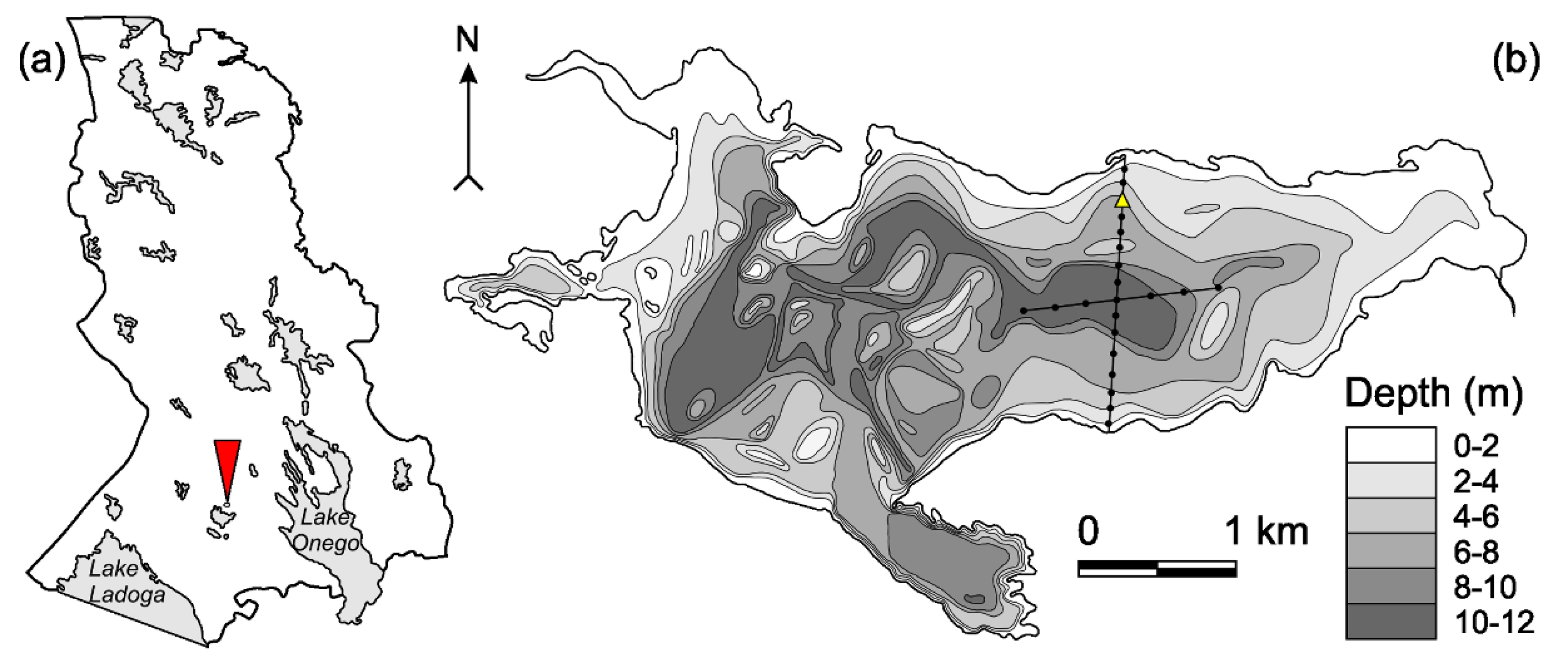
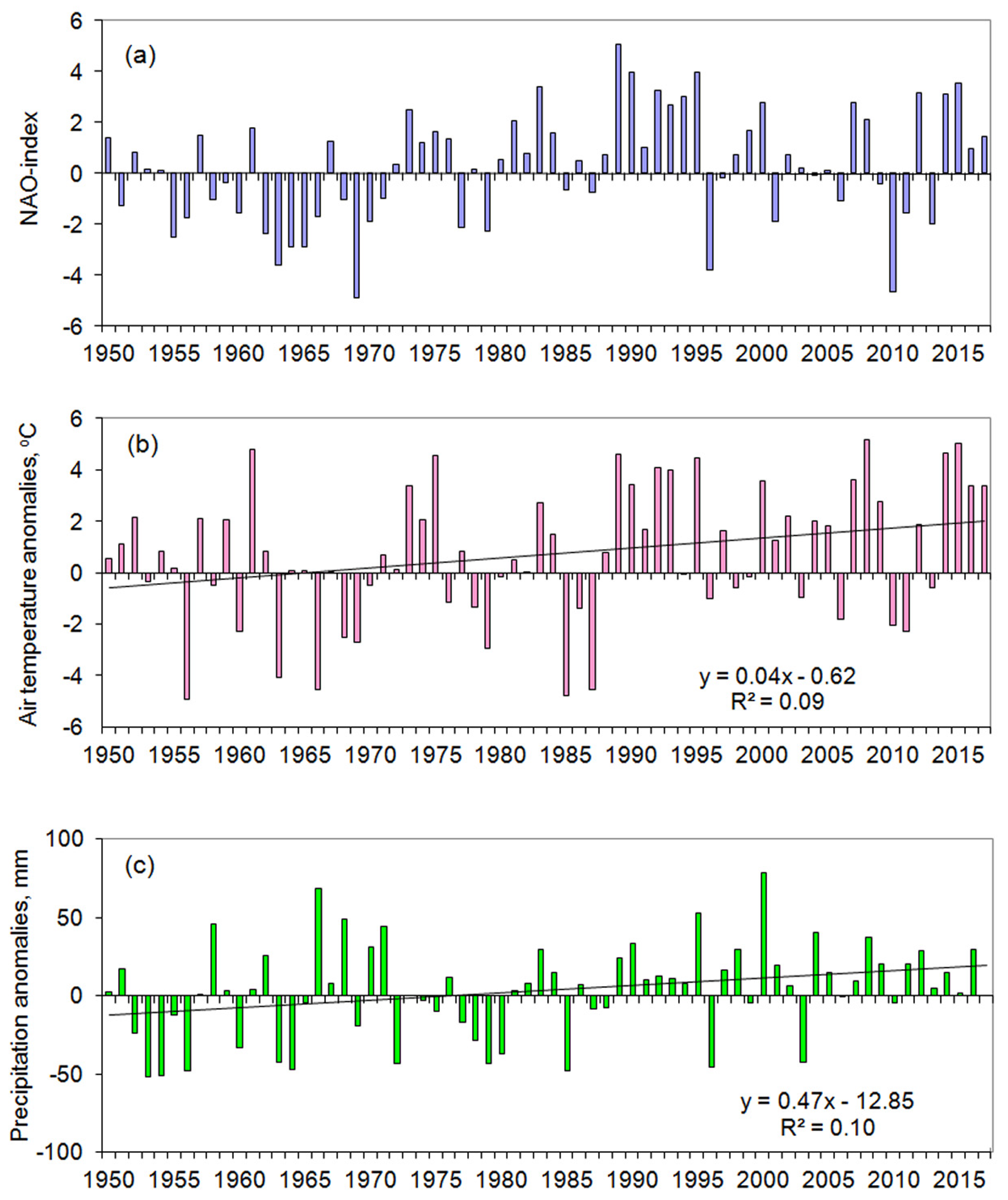
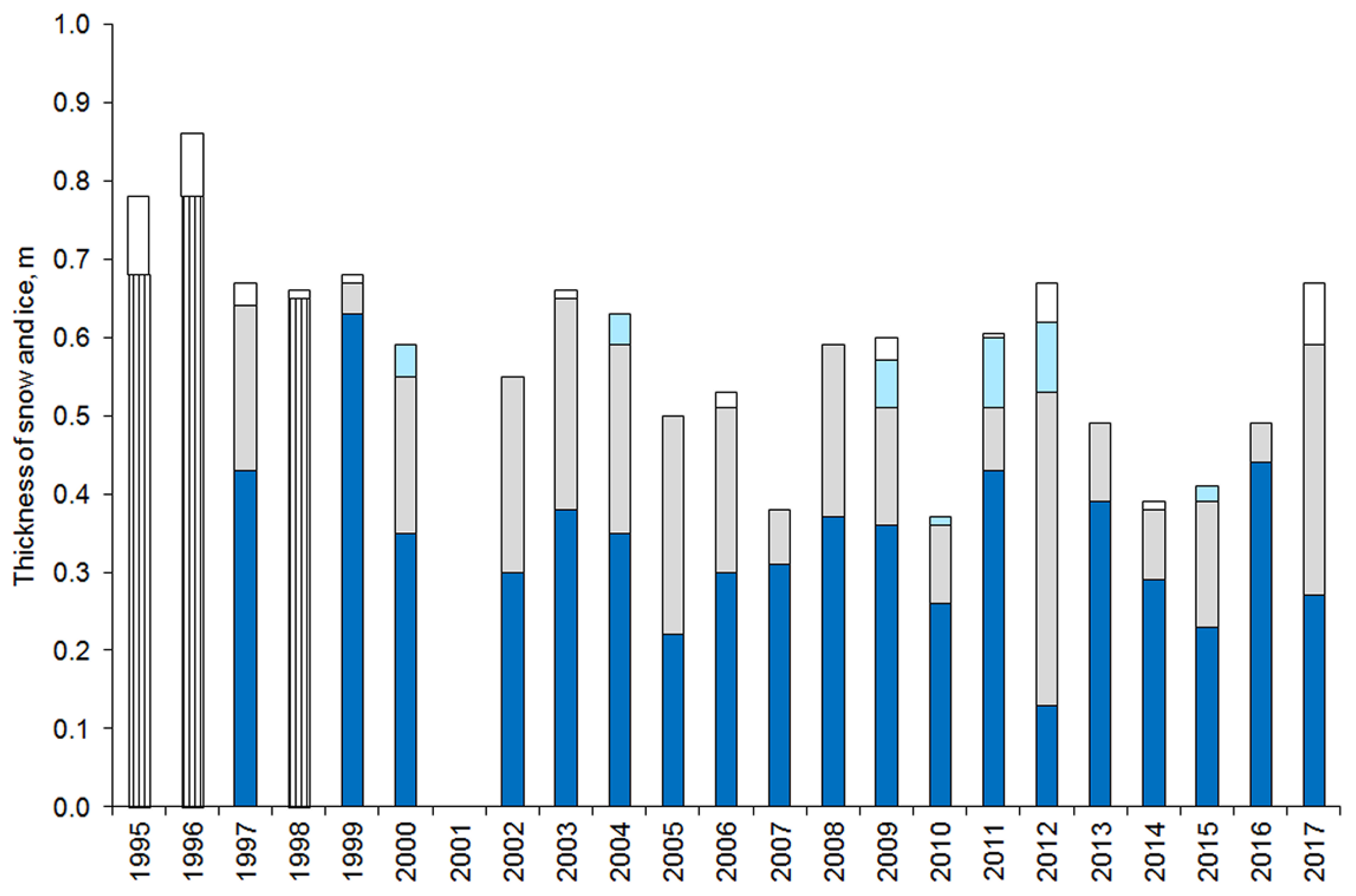

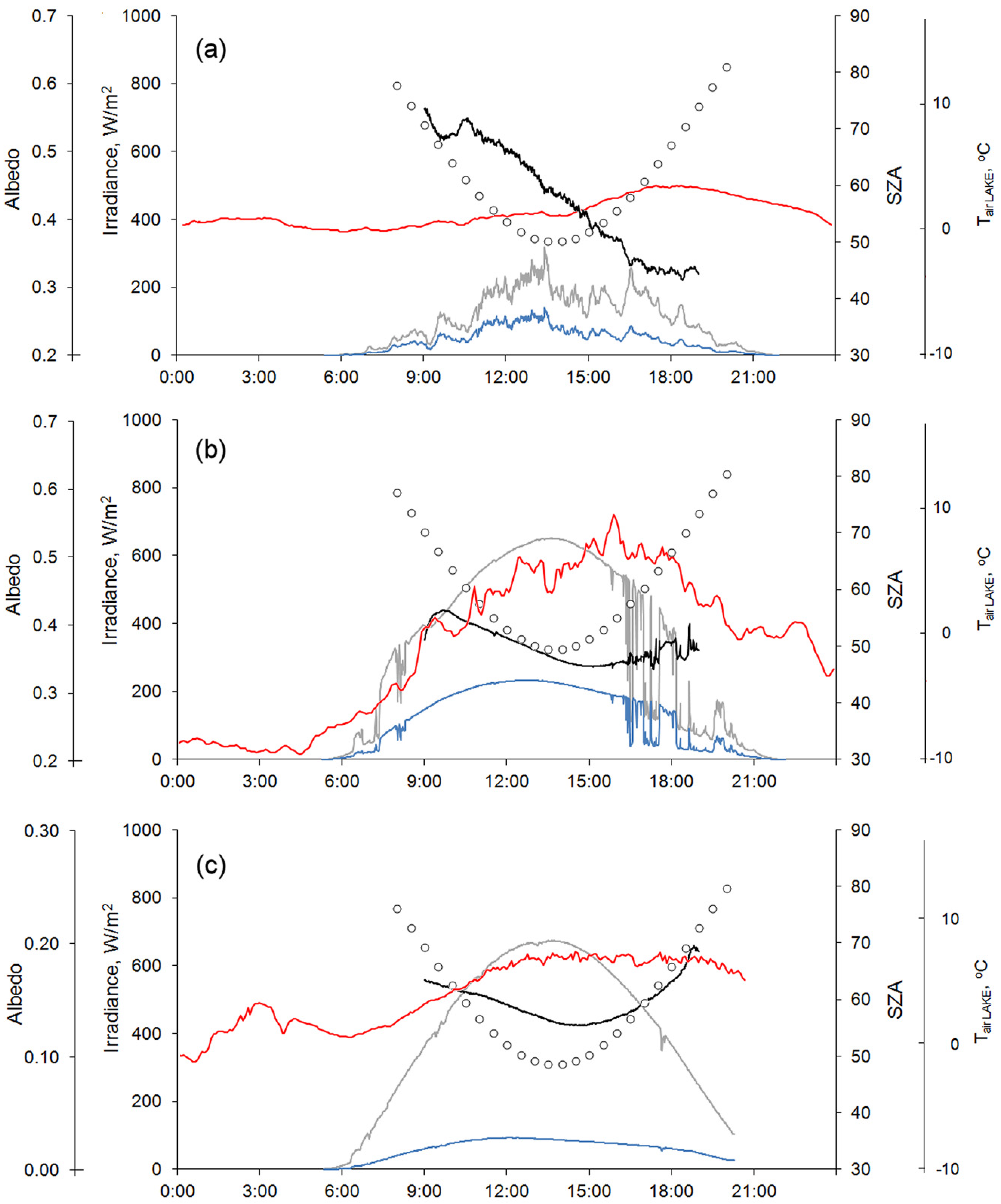
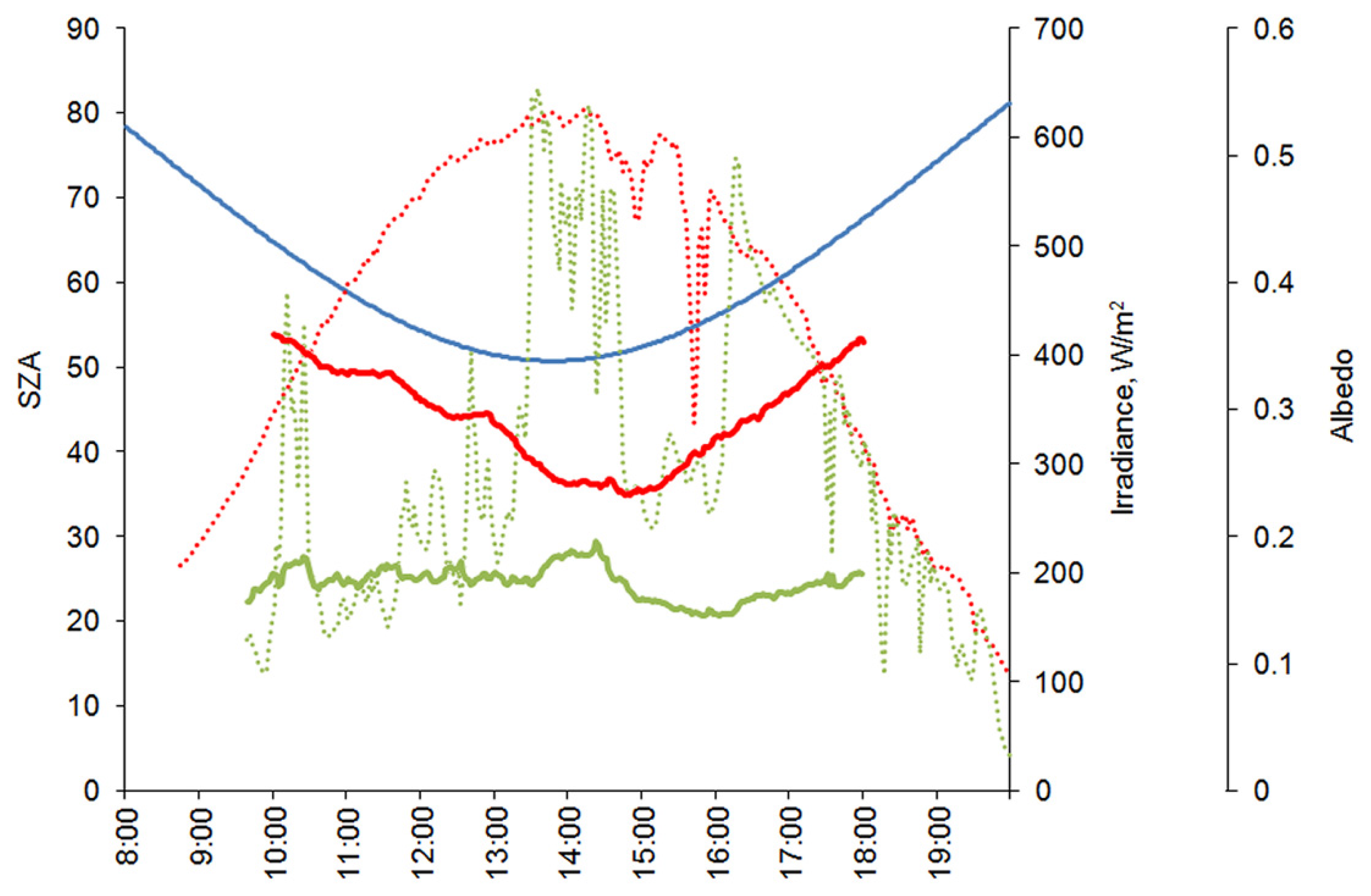
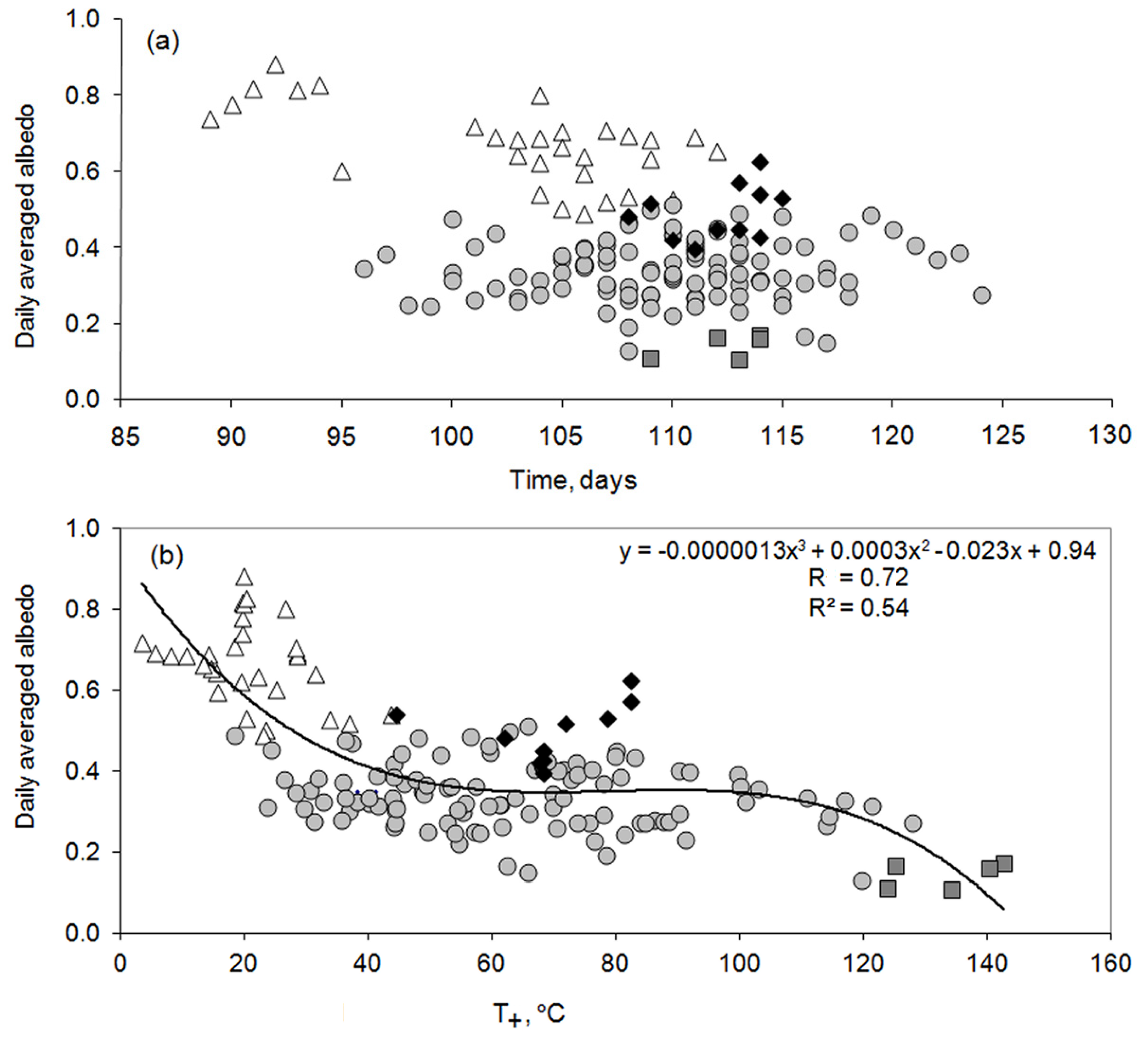
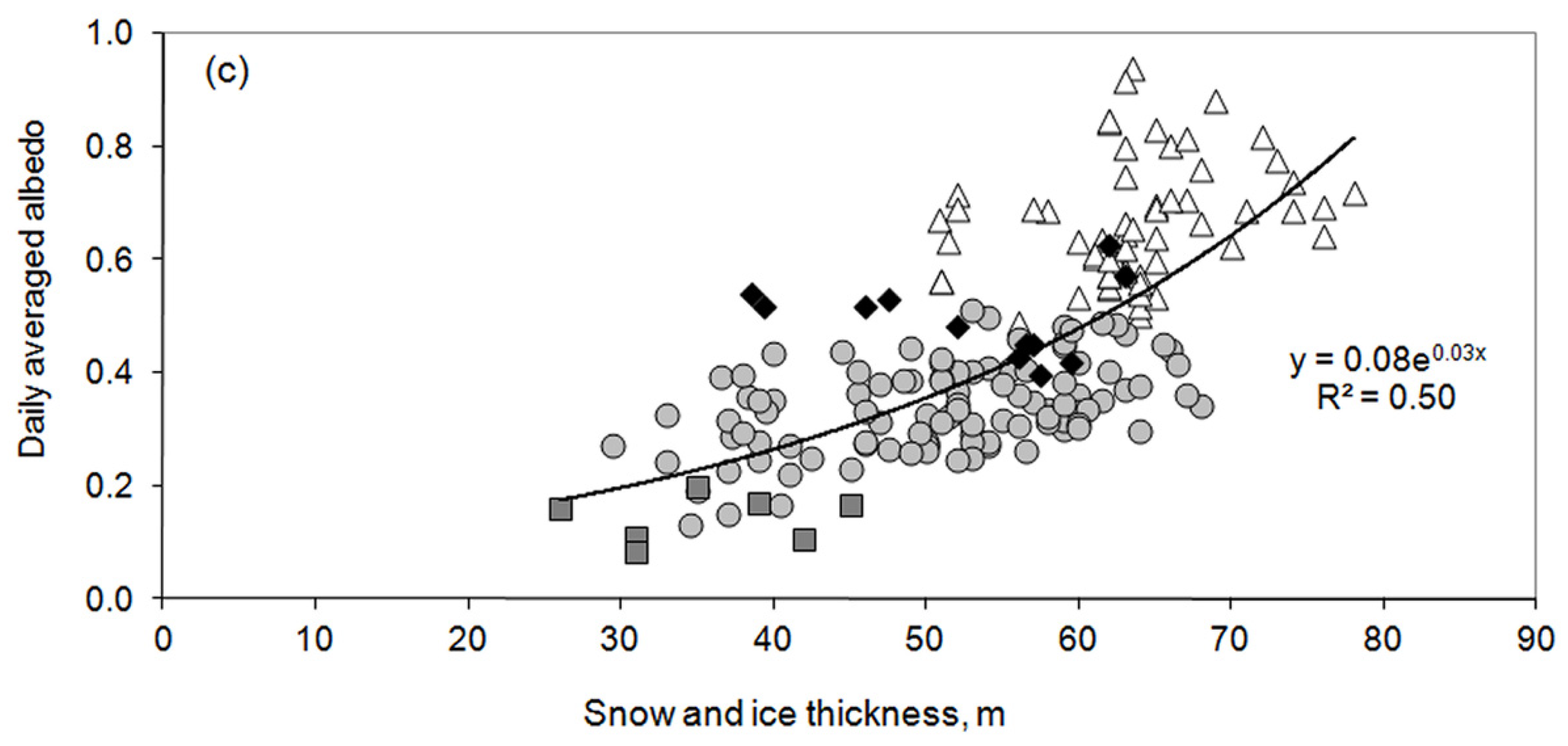
| Dates | Temporal Resolution, min | Irradiance Max (Avg), W/m2 | Albedo Max-Min | |
|---|---|---|---|---|
| Ed | Eup | (Avg) | ||
| 13–23.04.1995 | 5 | 760 (160) | 530 (56) | 0.78–0.18 (0.35) |
| 27–29.11.1995 | 5 | 95 (6) | 63 (5) | 0.94–0.62 (0.82) |
| 27.12.1995 | 2 | 70 (12) | 65 (11) | 0.99–0.77 (0.89) |
| 25–27.03.1996 | 2 | 575 (135) | 402 (104) | 0.93–0.68 (0.78) |
| 18–25.04.1996 | 5 | 733 (154) | 433 (66) | 0.74–0.20 (0.42) |
| 14–27.04.1997 | 2 | 920 (167) | 587 (95) | 0.86–0.37 (0.57) |
| 28.04–04.05.1998 | 2 | 755 (295) | 357 (124) | 0.52–0.26 (0.41) |
| 14–24.04.1999 | 2 | 785 (280) | 510 (85) | 0.76–0.09 (0.29) |
| 13–24.04.2000 | 2 | 722 (258) | 340 (93) | 0.58–0.10 (0.35) |
| 28–30.01.2002 | 2 | 198 (19) | 129 (13) | 0.98–0.60 (0.71) |
| 21–23.03.2002 | 2 | 465 (52) | 382 (42) | 0.98–0.72 (0.80) |
| 23.03.2002 * | 0.82–0.52 (0.69) * | |||
| 24.03.2002 * | 0.89–0.48 (0.69) * | |||
| 15–24.04.2002 | 2 | 806 (161) | 668 (85) | 0.97–0.29 (0.56) |
| 22.04.2002 * | 0.42–0.28 (0.34) * | |||
| 23.04.2002 * | 0.54–0.37 (0.42) * | |||
| 19–26.04.2003 | 2 | 858 (202) | 660 (110) | 0.84–0.29 (0.52) |
| 18–28.04.2004 | 2 | 825 (356) | 361 (139) | 0.54–0.17 (0.39) |
| 16–25.04.2005 | 2 | 897 (198) | 636 (114) | 0.82–0.32(0.58) |
| 16–27.04.2006 | 1 | 885 (175) | 340 (51) | 0.60–0.13 (0.31) |
| 24.04.2006 * | 0.59–0.32 (0.40) * | |||
| 27.04.2006 * | 0.34–0.13 (0.26) * | |||
| 13–19.04.2007 | 1 | 895 (147) | 530 (56) | 0.71–0.08 (0.36) |
| 16.04.2007 * | 0.54–0.19 (0.32) * | |||
| 19.04.2007 * | 0.43–0.17 (0.32) * | |||
| 12–20.04.2008 | 1 | 922 (136) | 645 (89) | 0.82–0.46 (0.65) |
| 21–28.04.2009 | 1 | 921 (193) | 473 (74) | 0.69–0.23 (0.39) |
| 17–19.04.2010 | 1 | 738 (125) | 140 (27) | 0.25–0.13 (0.21) |
| 17–21.04.2011 | 1 | 954 (163) | 447 (73) | 0.58–0.23 (0.45) |
| 11–24.04.2012 | 1 | 978 (129) | 552 (72) | 0.89–0.22 (0.56) |
| 20–24.04.2013 | 1 | 893 (168) | 223 (40) | 0.34–0.07 (0.71) |
| 26–31.03.2014 | 1 | 981 (217) | 572 (119) | 0.89–0.27 (0.58) |
| 10–16.04.2015 | 1 | 804 (200) | 327 (71) | 0.56–0.21 (0.33) |
| 8–13.04.2016 | 1 | 894 (132) | 264 (36) | 0.43–0.18 (0.26) |
| 30.03–10.04.2017 | 1 | 836 (115) | 665 (79) | 0.92–0.28 (0.68) |
| Dates | Snow and Ice Thickness | |
|---|---|---|
| Avg (Std), cm | ||
| Sn | TI | |
| 29.11.1995 | 12 (5) | 16 (2) |
| 25.12.1995 | 13 (3) | 41 (3) |
| 21.03.1996 | 26 (4) | 67 (4) |
| 18.02.1998 | 24 (4) | 57 (4) |
| 05.12.1998 | 1 (0) | 22 (1) |
| 08.12.1998 | 14 (2) | 23 (1) |
| 20.02.1999 | 22 (3) | 60 (2) |
| 01.03.1999 | 24 (3) | 61 (3) |
| 26.01.2002 | 24 (6) | 45 (4) |
| 22.03.2002 | 17 (6) | 61 (3) |
© 2018 by the authors. Licensee MDPI, Basel, Switzerland. This article is an open access article distributed under the terms and conditions of the Creative Commons Attribution (CC BY) license (http://creativecommons.org/licenses/by/4.0/).
Share and Cite
Zdorovennova, G.; Palshin, N.; Efremova, T.; Zdorovennov, R.; Gavrilenko, G.; Volkov, S.; Bogdanov, S.; Terzhevik, A. Albedo of a Small Ice-Covered Boreal Lake: Daily, Meso-Scale and Interannual Variability on the Background of Regional Climate. Geosciences 2018, 8, 206. https://doi.org/10.3390/geosciences8060206
Zdorovennova G, Palshin N, Efremova T, Zdorovennov R, Gavrilenko G, Volkov S, Bogdanov S, Terzhevik A. Albedo of a Small Ice-Covered Boreal Lake: Daily, Meso-Scale and Interannual Variability on the Background of Regional Climate. Geosciences. 2018; 8(6):206. https://doi.org/10.3390/geosciences8060206
Chicago/Turabian StyleZdorovennova, Galina, Nikolay Palshin, Tatyana Efremova, Roman Zdorovennov, Galina Gavrilenko, Sergey Volkov, Sergey Bogdanov, and Arkady Terzhevik. 2018. "Albedo of a Small Ice-Covered Boreal Lake: Daily, Meso-Scale and Interannual Variability on the Background of Regional Climate" Geosciences 8, no. 6: 206. https://doi.org/10.3390/geosciences8060206





